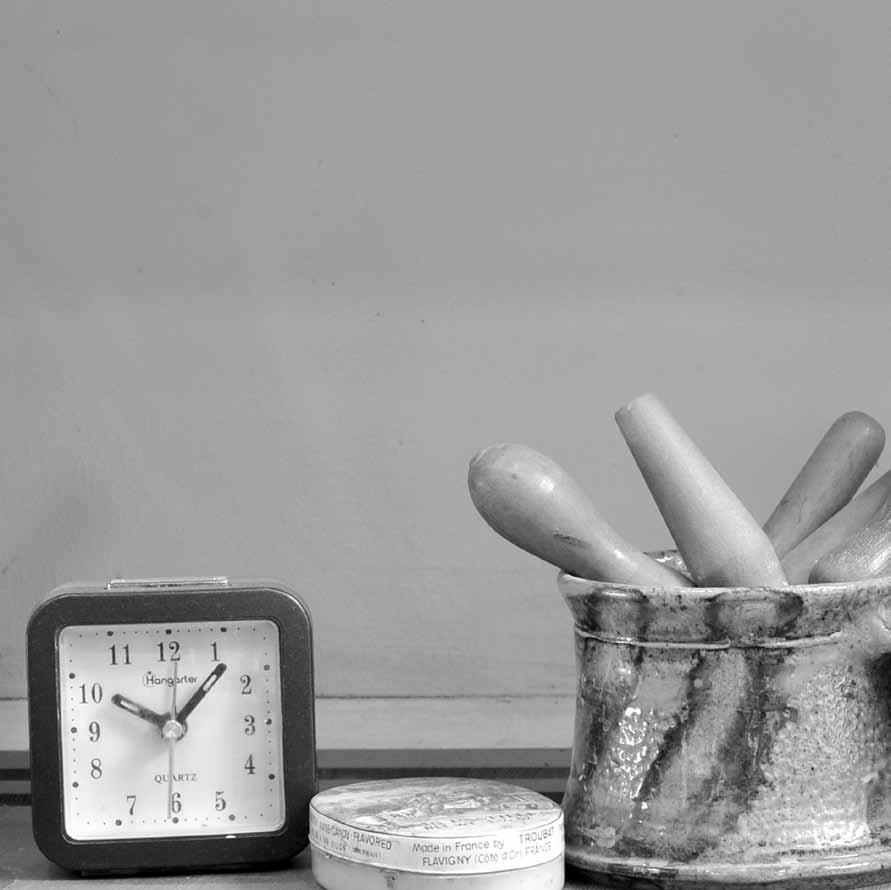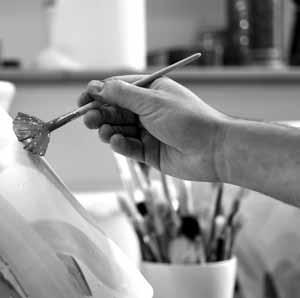Métier d’Art POTIER


Métier d’Art POTIER
It’s easy to understand a potter’s work if you’re willing to adopt the witty axiom of one of France’s most eminent clay artists, Claude Champy, for whom, “A pot is no more than a void surrounded by clay walls!”. From there on, as in a marriage, anything is possible, for the better or for the worse! In his case, it’s the beginning of a voyage towards unsuspected wonders; in ours, it’s the submission to function which will impose a multitude of culinary or domestic requirements.
“But,” you may ask, “Isn’t this potter’s craft a bit outdated these days? Isn’t it even inherently anachronistic?” Well, you’re probably right, but it certainly isn’t obsolete. Why not change registers, and look, for example, at the works of Racine or Shakespeare. To steep one’s self in refined language, even if it was written centuries ago, creates, for those willing to take the trouble, not only a perfectly modern feeling of delight, but also a salutary sense of cultural rootedness. When savouring the verses of Andromache or Macbeth we perceive a fragment of our origins, we enrich our imaginations and we consolidate our notions of belonging.
You may find this analogy a wee bit bold, but the principle of appreciation is in fact identical, even if, rather obviously, it’s not every potter who reaches the stratosphere of the great poets. Witness the careful crafting, the care over minutiae, the traces of the hand that sign the creative act; all these details speak imperiously of man and of a heritage respected.
Evidently, studio pottery can no longer answer to the same economic imperatives that found the industrial ethos. Instead it has become, decades ago, a joyous constituent of dreams. So now, it’s up to the potter to ensure that the luxury of his art remains affordable, that the esteem his artifacts generate exceeds by far their cost. Today, a pot participates in personal aspirations; furnishes other people’s dreams. Domestic, culinary or decorative dreams, common dreams, dreams built on identity, secret gardens or closed doors, it’s really not important. As in all art, the humble pot is no more than a gateway opening out to others. The potter provides the keys. It’s then up to you to open your eyes, to inform your judgment and to decide, or not, to embrace this ceramic offer of sharing, of intimate communion which will henceforth renew itself each day.
Nigel ATKINSComprendre l’acte du potier devient clair si vous faites vôtre la formule d’un des plus éminents maîtres français, Claude Champy, pour qui « un pot n’est qu’un vide entouré de parois d’argile » ! Alors, comme dans un mariage, tout devient possible pour le meilleur ou pour le pire. Dans son cas, c’est le début d’un voyage vers des merveilles insoupçonnées; dans le nôtre, c’est l’emprise de l’usuel qui impose sa multitude de besoins culinaires et domestiques.
Mais, me direz-vous, ce métier de potier est-il encore contemporain ? N’est-il pas, fatalement, anachronique ?
Peut-être bien, mais peu importe, car d’évidence, il n’est pas obsolète ! Dans un autre registre, prenons Racine ou Shakespeare : s’imprégner du luxe d’un langage raffiné, même d’antan, provoque chez celui ou celle qui s’y livre, une jouissance on ne peut plus moderne et, dans le même temps, une sentiment d’enracinement tout à fait salutaire. En savourant les vers d’Andromaque ou de Macbeth, nous percevons un fragment de nos origines, nous étoffons notre imaginaire et nous solidifions notre appartenance identitaire.
Peut-être trouverez-vous cette comparaison audacieuse, mais le principe d’appréciation est identique, quand bien même tout potier n’atteint pas le firmament des grands poètes. Ce façonnage, ce soin du détail, ces traces de mains, résidus de l’acte créatif, tous parlent impérieusement de l’humain et célèbrent un héritage respecté.
D’évidence, la poterie d’atelier ne peut de nos jours répondre à l’exigence économique qui fonde la production industrielle. Elle est devenue, depuis quelques décennies, un allègre messager de rêve. Au potier donc de faire en sorte que ce luxe devienne abordable, que l’artefact l’emporte sur son coût ! Telle est sa tâche : répondre à des aspirations, meubler des rêves.
Rêve domestique, culinaire, décoratif, rêve identitaire ou populaire, jardin secret, portes fermées, qu’importe ! Comme dans tout art, l’humble pot n’est qu’un portail ouvrant sur l’autre. Le potier vous donne les clés, à vous d’éveiller votre regard, d’exercer votre discernement et de décider, ou non, d’embrasser cette offre de partage céramique, de communion intime.
Nigel ATKINS
La matière












La main
















Les outils














La Poterie du Don, un mythe moderne
D’abord il y a le lieu fondateur, Le Don, au site vertigineux, accroché à sa montagne cantalienne, une fermette perdue sans accès dans un paysage vertical. Ensuite il y a ce couple, Nigel et Suzy, amoureux du pays et des pots, sans le sou et parfaitement inconscients de l’énormité de l’effort qui les attend. Y installer une poterie ambitieuse, ne paraitrait-il pas un pari perdu d’avance ? C’est sans compter sur une ténacité partagée et l’art potier de Suzy qui sut charmer les cœurs des premiers pèlerins du beau avant même les critiques d’art. L’atelier du Don devient une référence nationale et l’affluence s’accroit.
Mais ce succès a son revers. Périlleux goulet d’étranglement, la petite route en lacets devient vers la fin des années ‘90 un obstacle physique et économique. Le Don « craque » sous l’affluence. Il faut partir, se réinstaller ailleurs plus au large, mais sans perdre ce caractère d’exception, cette faculté d’étonner, d’émerveiller. C’est affaire de géographie et d’architecture. L’Aveyron voisin en saisit l’opportunité, proposant un site au panorama à couper le souffle, un architecte de choc et un partenariat juste. Le Don du Fel, pôle européen pour la céramique contemporaine, ouvre en juillet 2007. Nouveauté fabuleuse dans un paysage d’exception, mi-oasis céramique, mi-aimant culturel, elle attire, chaque année, plus de 50 000 visiteurs.
Le Don du Fel est composé de : l’atelier de Suzy et Kélian Atkins, : l’atelier de la Poterie du Don, : une boutique avec des pièces de Suzy, Kélian, la Poterie du Don et d’une cinquantaine de créateurs venant d’une dizaine de pays européens, : la Galerie du Don qui organise des expositions exceptionnelles tout au long de l’année.


La Poterie du Don, a modern myth
First, there was Le Don, an improbable hill-farm lost in the vertical wilderness of the southern Cantal. Then there was this couple, Nigel and Suzy, in love with both the landscape and the world of pots, pretty much penniless and blithely unaware of the immensity of the efforts yet to come. Didn’t they understand that this was no place to start a pottery? But, as is so often the case, shared tenacity paid, and of course there was Suzy’s striking pottery, which from the very beginning delighted the intrepid visitors well before convincing the art critics. As the renown of La Poterie du Don spread to rapidly become a national reference, the number of customers increased.
But success has its drawbacks and by the end of the 90’s the narrow zigzag mountain road could no longer cope with the increasing flow of the summer traffic. A move seemed unavoidable, but where to go and what to build to generate the same sense of wonder and astonishment that had always struck every visitor to Le Don ?
Clearly a question of geography and architecture, and it was the neighboring Aveyron who seized the opportunity, proposing a package which included an accessible hilltop with breathtaking views, a brilliant architect and balanced funding. Le Don du Fel, France’s first European Pole for Contemporary Ceramics opened in 2007. Immediately acclaimed internationally as an outstanding building in an exceptional landscape, this ceramic oasis works like a cultural magnet, attracting more than 50 000 visitors every year.
Le Don du Fel comprises : the studio of Suzy et Kélian Atkins,

: the studio of the Poterie du Don,
: an exhibition space showing the work of Suzy, Kélian and the Poterie du Don as well as the work of fifty other artists coming from all over Europe,
: the Galerie du Don which organizes exceptional exhibitions throughout the year.
Other information, also available on www.ledondufel.com
REMERCIEMENTS
Merci à la Poterie du Don pour leur accueil et leur collaboration à la réalisation de cet ouvrage. Merci à Olivier Nicolas et toute l’équipe de Graphi imprimeur pour leurs conseils.
Editions Au fil du Temps
Route de Trinquies
12 330 SOUYRI (France)
www.fil-du-temps.com
Direction artistique : SICHI Stéphane
N° ISBN : 978-2-918298-10-6
Dépot Légal : Juillet 2011
Achevé d’imprimer en juillet 2011 sur les presses de Graphi Imprimeur à Rodez , Aveyron
Dans la même collection
Métier d’Art
TAILLEUR DE PIERRE
GANTIER
POTIER
COUTELLIER
MAÎTRE VERRIER
ISBN : 978-2-918298-10-6

